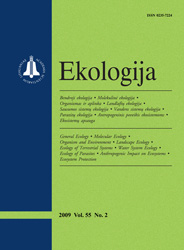 ISSN 0235-7224 ISSN 2029-0586 (online) |
2008 m. Nr. 3 Spatial peculiarities of Lithuania’s soil cover structure in the landscape context
A general theory of soil science is presented in this article. The conception of soil cover as an integral body having an original spatial structure is developed, and a new method of this structure cognition is presented. The research methodology is based on a complex outlook employing integrally the GIS analysis, cartographic and logic methods. A territorial unit of the statistical grid is suggested as a foothold in the methodology of soil cover structure analysis. Due to the scale and particularity of the map under consideration, a statistical grid of 2 × 2 km was chosen. The soil cover structure is considered as a spatial dispersion of soil cover diversity and contrast features, which determine its complexity and structurality expressed in points, establishing them on evaluating the spatial dispersion of the cover areal and linear elements. The spatial variety of the grain-size composition of a territory has the greatest influence on the degree of soil cover diversity, while the degree of cover contrast depends on the territorial peculiarities of soil pH. A distinctly higher complexity of soil cover is characteristic of uplands rather than of lowlands, as well as of genetically heterogeneous territories of the surface rather than of homogeneous ones. The soil cover structurality types in which diversity is more pronounced are more characteristic of uplands (except the Medininkai upland) than of plains (except sandy plains). Meanwhile, the cover types where contrast is more evident or territorial structurality is low are more characteristic of plains and deposits of a minor grain-size composition as well as of territories affected by periglacial weathering. Keywords: soil cover structure, diversity, contrast, complexity, structurality, landscape |
Issues:
2011 - Vol.57 No. 1, No. 2 2010 - Vol.56 No. 1-2, No. 3-4 2009 - Vol.55 No. 1, No. 2, No. 3-4 2008 - Vol.54 No. 1, No. 2, No. 3, No. 4 2007 - Vol.53 No. 1, No. 2, No. 2.priedas, No. 3, No. 4 2006 No. 1, No. 2, No. 3, No. 4 2005 No. 1, No. 2, No. 3, No. 4 2004 No. 1, No. 2, No. 3, No. 4 2003 No. 1, No. 2, No. 3, No. 4 2002 No. 1, No. 2, No. 3, No. 4 2001 No. 1, No. 2, No. 3, No. 4 |